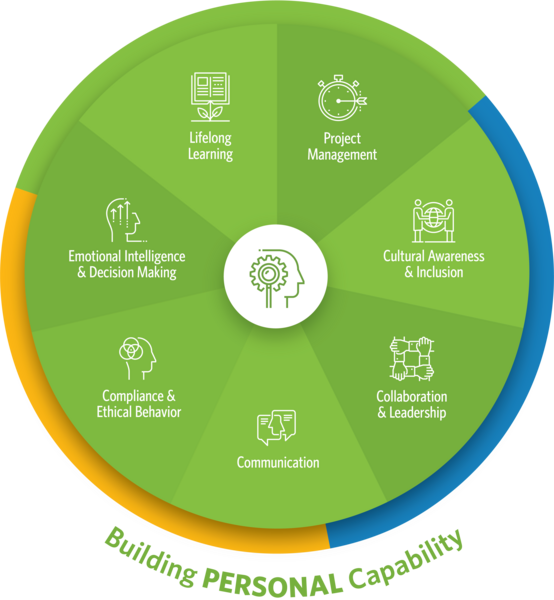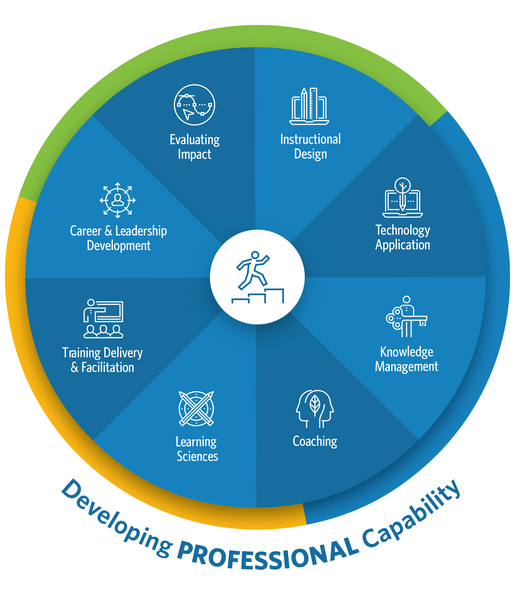TD Magazine Article
Competency Out, Capability In
ATD’s new Capability Model introduces the capabilities talent development professionals should have to be successful.
Fri Jan 31 2020

ATD's new Capability Model introduces the capabilities talent development professionals should have to be successful.
The Association for Talent Development's latest competency model study reveals that the future of work will require TD professionals to use interpersonal skills, along with their professional expertise, to work as true business partners to help achieve organizational goals. That's why the new Talent Development Capability Model elevates the TD function to the level of a key contributor to an organization's success. This new standard for the field will help prepare TD professionals for the future of work by broadening the scope of knowledge and skills that will make them effective. There is no professional better positioned to help organizations navigate the changes that are coming, and TD professionals themselves need to be ready to meet that change.
Since 1978, ATD has been developing competency models, all of which have focused on the specific technical skills required of those in the industry. The release of the new framework, however, means that competency is out and capability is in.
Competence has become a somewhat outdated and passive term. It refers to a person's current state and to them having the knowledge and skills necessary to perform a job. Capability is about integrating knowledge and skills and adapting and flexing to meet future needs. By shifting from a competency model to a capability model, ATD is helping TD professionals put their knowledge and skills to work to create, innovate, lead, manage change, and demonstrate impact.
Establishing an international standard for TD practice
The foundation of the 2019 capability model research entailed capturing the major shifts in society and the larger business landscape since ATD published its previous model in 2013. Researchers identified the major changes in the field through a comprehensive literature review, expert practitioner interviews, and advisory group discussions. These trends spanned a variety of areas in business, technology, learning, science, and the profession itself and were directly incorporated into the research to determine their impact on future skill requirements for practitioners.
The research results indicate that effective TD now requires a proactive, business-partner approach to anticipate and respond to changing needs and to leverage personal capabilities to support organizational strategy and generate competitive advantage. The foundational research led ATD to create a set of original knowledge and skill statements that describe all the possible things that a TD professional may need to know and be able to do to be effective.
Researchers put these statements, 197 of them, into an occupational survey that ATD distributed to its member and customer base, to all individuals certified as an Associate Professional in Talent Development or Certified Professional in Learning and Performance, and through an open link that TD professionals were encouraged to share with their networks. Respondents were asked to rate how important a knowledge and skill statement is to their ability to perform in their role today and five years into the future.
ATD received the largest-ever response to its competency study. The range of data obtained enabled the association to reflect on the global nature of the work TD professionals are doing and shows little difference between what those in varying parts of the world, different size organizations, or disparate industries need to know and be able to do to succeed.
Overwhelmingly, respondents rated the importance of tasks related to business partnering and those that affect organizational strategy and success equally to—and, in some cases higher than—tasks traditionally viewed as necessary in the training development and delivery field. Similarly, ratings of knowledge and skill areas—such as communication, business acumen, and having a global mindset, which previously were considered foundational or enabling—showed the increased importance of these interpersonal abilities to success.
The resulting Capability Model has three equal domains of practice centered around personal skills, professional expertise, and contributing to organizational success. Among them, there is no hierarchy of importance of the knowledge and skills TD professionals must develop; they will need to leverage topics across all three domains for success and effectiveness.
Previous competency models lent themselves to TD practitioners zeroing in on a key area that they felt represented the totality of their role. In contrast, the Capability Model demonstrates the need for TD professionals to blend knowledge and skills across the three domains and each of the capabilities to be most effective.
Under the three domains, ATD has established 23 capabilities that contain the specific knowledge and skills TD professionals can harness for maximum impact.
Building personal capability
This domain embodies the foundational or enabling abilities all working professionals should possess to be effective in the business world. TD professionals need these largely interpersonal skills, often called soft skills, to build effective organizational or team culture, trust, and engagement. Other research supports the need to focus on, and elevate, these knowledge and skill areas. For example, IBM's 2019 report on the future of work, The Enterprise Guide to Closing the Skills Gap, states that "Skilled humans fuel the global economy. Digital skills remain vital; however, executives tell us soft skills have surpassed them in importance."

These areas are of particular value to TD professionals who need to be able to persuasively communicate solutions and guide individuals and teams to improved performance.
The domain includes these capabilities:
Communication. As TD professionals become critical business partners, they will need to articulate the appropriate messages for a particular audience.
Emotional intelligence and decision making. Emotional intelligence and the ability to make good decisions are paramount to professional success. Regulating emotions and correctly interpreting the verbal and nonverbal behaviors of others is a key strength in building rapport and trust with others.
Collaboration and leadership. Leadership is about influence and vision, which also helps to facilitate collaboration. Being good at collaboration requires the ability to foster environments that encourage teamwork and respectful relationships, especially cross-functionally. Effective leaders inspire trust and engagement with their employees and teams.
Cultural awareness and inclusion. Being effective at cultural awareness and fostering an inclusive work environment means conveying respect for different perspectives, backgrounds, customs, abilities, and behavior norms, as well as ensuring all employees are respected and involved by using their capabilities, insights, and ideas.
Project management. Effective project management requires being able to plan, organize, direct, and control resources for a finite period to complete specific goals and objectives.
Compliance and ethical behavior. TD professionals must act with integrity and operate within the laws that govern where they work and live.
Lifelong learning. This is marked by traits such as self-motivation, insatiable curiosity, and intelligent risk-taking. TD professionals should model its value by pursuing knowledge for personal and professional reasons.
Developing professional capability
This domain embodies the knowledge and skills TD professionals should possess to be effective in their roles of creating the processes, systems, and frameworks that foster learning, maximize individual performance, and develop employees' capacity and potential. The core professional skills that are the mainstay of the 2013 competency model—such as instructional design, evaluating impact, and training delivery—are essential elements of the new model. In fact, all the former areas of expertise (AOEs) are in the new model, albeit with some newer labels. Additionally, all the knowledge areas and key actions from the previous model are within the new model.
The specialized skills in this domain are necessary for identifying, developing, and delivering effective learning solutions. Practitioners not directly involved in development and delivery will be better business partners and advocates if they understand these key elements of TD.

This domain includes these capabilities:
Learning sciences. Organizations with highly effective learning programs incorporate key principles from the learning sciences—the interdisciplinary research-based field that works to further the understanding of learning, learning innovation, and instructional methodologies.
Instructional design. The creation of learning experiences and materials is what results in the acquisition and application of knowledge and skills.
Training delivery and facilitation. These are the means by which TD professionals help individuals improve performance at work by learning new skills and knowledge.
Technology application. TD professionals must have the ability to identify, select, and implement the right learning and talent technologies that serve the best interests of the organization and its people.
Knowledge management. Knowledge management is the explicit and systematic management of intellectual capital and organizational knowledge. In a knowledge economy, lost institutional knowledge can cost organizations real money in the form of turnover, recruitment, and training costs.
Career and leadership development. Being effective at career and leadership development requires the ability to create planned processes of interaction between the company and the individual.
Coaching. This discipline and practice is an essential capability for any TD professional, and it has the power to catalyze breakthroughs to enhance individual, team, and organizational performance.
Evaluating impact. TD professionals should be able to implement a multilevel, systematic method assessing the effectiveness and effort of learning programs.
Impacting organizational capability
This domain embodies the knowledge, skills, and abilities professionals need to ensure TD is a primary mechanism driving organizational performance, productivity, and operational results. TD professionals are in the unique position of having insight into a company's workforce, coupled with the ability to link that human capital to the skills most needed to attain a business-critical mission and goals.

This domain includes these capabilities:
Business insight. Business insight is the understanding of key factors affecting a business, such as its current situation, influences from its industry or market, and matters influencing growth. Having business insight is essential to strategic involvement with top management and ensuring TD strategies align with overall business strategy.
Consulting and business partnering. These use expertise, influence, and personal skill to build a two-way relationship that facilitates change or improvement in the business.
Organization development and culture. Organization development is an effort that focuses on improving a company's capability through alignment of strategy, structure, management processes, people, rewards, and metrics.
Talent strategy and management. These are the practices used to build an organization's culture, engagement, capability, and capacity through the implementation and integration of talent acquisition, employee development, retention, and deployment processes—ensuring these processes are aligned to organizational goals.
Performance improvement. Organizational competitiveness is fueled by improvement in human performance. Performance improvement is a holistic and systematic approach to meeting organizational goals by identifying and closing human performance gaps.
Change management. This is the capability for enabling change within a company by using structured approaches to shift individuals, teams, and organizations from a current state to a future state.
Data and analytics. This entails the ability to collect, analyze, and use large data sets in real time to influence learning, performance, and business.
Future readiness. The pace of change requires constant upskilling and reskilling of the workforce. Future readiness requires intellectual curiosity and constant scanning of the environment to stay abreast of forces shaping the business world, employees and their expectations, and the TD profession.
How to use the model
In addition to introducing a new visual framework for TD capabilities, ATD has developed tools and an interactive website (td.org/CapabilityModel) to assist professionals in exploring the new model, assessing themselves against the new standard, and identifying resources to assist them in their professional growth and development.
Individuals may use the model to explore job or career expansion or to help prepare for professional certification (the new model serves as the foundation of ATD's Certification Institute credentials). Academic institutions, professional groups, and others involved in educating those who will perform TD functions may use the model to benchmark and align their curriculums. And TD managers and leaders may use the model to establish which roles they need to fill and which skill sets are required of their staff. Each stakeholder group will have different needs in relation to how it uses the model.
Using the interactive website, individuals can assess their current knowledge and skill proficiency against this new standard. The assessment identifies knowledge and skills gaps, which they can save to their ATD profiles. TD professionals can prioritize identified gaps for development and link directly to ATD resources that can help them close those gaps. They can use these customized gaps reports to design a professional development pathway and track their progress against that plan.
At any time, individuals can come back and reassess themselves against the standard and update their learning goals. The self-assessment can also help them uncover how their careers may evolve over time and what jobs they may want to pursue in the future.
Managers can use the interactive model to have teams assess themselves so they can identify common gaps and develop team learning plans. ATD resources, ranging from job aids and TD magazine articles to courses and downloadable books or webcasts, are linked directly to the knowledge and skills that must be developed, making it easy to identify personalized or group learning solutions. Managers can also use the new model to design job roles and structure teams, departments, and the TD function.
Ultimately, the model can help TD professionals answer:
What are the skills required for the role I am currently in?
What skills will I need to be successful as my role evolves?
What skills will I need to be successful as my organization evolves?
What skills will I need to align to evolutions in my industry?
What jobs may I want to pursue in the future?
What skills and credentials will I need to pursue my career aspirations?
A blueprint for impact
The Talent Development Capability Model defines the standard of excellence and helps lead the profession by empowering TD professionals to elevate their skills and by enabling organizations to strategically align learning and TD opportunities to business outcomes. The interactive model can serve an informational role in capturing what TD professionals most need now and in the future, but its value stems from its potential application through assessment, personalized learning plans, and direct linkage to learning solutions. If TD professionals develop themselves and their teams in line with this new standard, they can best position themselves to drive a learning agenda that will help organizations navigate the future.

